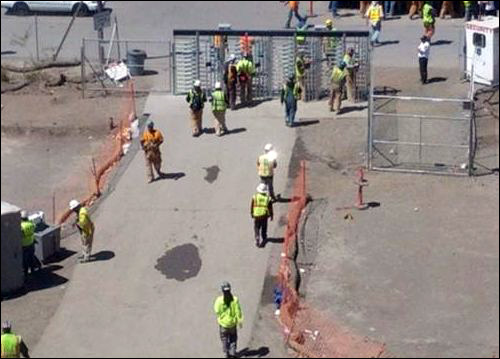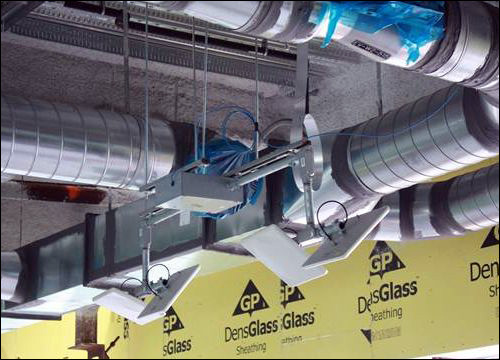By employing an RFID-based solution, general contractor DPR Construction has found a new way to manage building safety and access at the construction site for the University of California, San Francisco (UCSF) Medical Center at Mission Bay. The solution, provided by Trimble‘s ThingMagic division, enables the general contractor to ensure that all individuals are safely evacuated during an emergency, prevent site access by unauthorized personnel, and control access to clean or completed spaces on the project. DPR is using ultrahigh-frequency (UHF) RFID readers and ID cards, as well as and Trimble’s cloud-based server integrated with BIM software to better manage security-sensitive work areas, workforce logistics and project planning.
Many commercial construction projects require that hundreds of workers be onsite from a variety of contracting and subcontracting companies, making it difficult to identify which employees have entered or exited at any given time. For DPR, safety issues related to confusion about onsite personnel are of paramount concern. For instance, if staff members need to be evacuated in a hurry, it is not always possible to know how many workers are onsite.
In August 2012, DPR installed the Trimble-ThingMagic solution at the UCSF construction project, where as many as a thousand workers enter and exit the 900,000-square-foot site daily, says Osman Chao, DPR Construction’s project executive. Some are authorized to enter only certain zones, based on their safety training. A majority of those onsite are not DPR employees, but rather electricians; heating, ventilation and air-conditioning (HVAC) specialists; plumbers; and other workers employed by subcontractors.
When construction on a new building commences, Chao explains, the management of worker egress is not as imperative, or sometimes even possible, since work is performed within an open area without walls. Once the shell is completed and employees begin working inside the building, however, that changes. Some workers have specific protocol training to ensure that they do nothing that could, for example, contaminate the area for future inhabitants (medical personnel and patients), such as bringing food onsite. Other individuals, however, should not be in those restricted “clean room” areas. The system is not meant to track worker’s exact locations and does not have the ability to do so, says Chao. Rather, it is designed to automate data collection for operational improvements and to reduce costs where possible.In the past, DPR has hired staff members to walk through an entire site to confirm that no unauthorized workers were in each area. The general contractor has also had to station personnel at entry points, equipped with paper and pen to manually count workers and verify that they are authorized to enter each area. With RFID, however, this is no longer necessary.
DPR Construction set up 19 zones, ranging in size from 15,000 to 120,000 square feet. A typical zone can be an entire floor, or just part of one. ThingMagic provided four RFID reader turnstiles at the building’s entrance and exit points, according to Bernd Schoner, ThingMagic’s cofounder and VP of business development. DPR then installed approximately 80 fixed reader portals at zone entrances—such as at an elevator or stairwell.
Upon arriving at the project site for the first time, a worker is issued a photo ID card, to be worn on a breakaway lanyard. Each of the cards, supplied by Vanguard ID, has a built-in passive EPC Gen 2 UHF RFID tag, encoded with a unique ID number linked to that individual’s details in the Trimble-ThingMagic RFID data-management software on a hosted server. Those details can include the worker’s name, protocol training level, home city or zip code, and employer.
Upon entering the facility, the worker must pass through a turnstile with a built-in ThingMagic Mercury6 RFID reader. The employee presents his tag to a reader, which captures the tag’s unique ID and forwards that information to the server via a wired connection. The server software then verifies that the individual is approved to pass through that turnstile, and releases the lock so that he can proceed inside, with the software storing data about that arrival. To ensure that each tag is presented one at a time in order to release the turnstile, the Mercury6 reader’s antennas are set for short-range, while the device’s power is set at a low level.
Once inside the building site, the worker walks through various zones, passing other Mercury6 readers (set for a standard, rather than short read range) wired to antennas hanging from the ceiling, approximately 3 meters (9.8 feet) above the floor. The interrogators capture the worker’s tag ID number, and the Trimble-ThingMagic software records that person’s zone location and updates his status. If one reader fails to capture the tag, the tag will be read at the next zone. If an individual enters a zone in which he is not authorized to be, the system e-mails an alert to the appropriate site manager so that they can inform a worker that they are in an unauthorized area.Although safety is DPR Construction’s primary incentive for using the technology, Chao says, the company can also utilize zone data for the purpose of analysis, such as determining whether any particular part of the project is on time or behind schedule. “Traditionally,” he states, “contractors have had to wait long periods of time for manual reports from subcontractors to validate build progress. The RFID software allows us to have proactive discussions with subcontractors and gives us a better understanding of our progress against our plans.”
The system has also made it possible for DPR Construction to automate the collection of workforce information for UCSF. For example, the university has a goal of employing a certain percentage of construction staff from within the City of San Francisco. Because workers report their zip code or home city upon registering for the RFID tag, data is available indicating community workforce participation.
With RFID-enabled turnstiles instanced at the facility’s entrance, the company can be assured that all workers bring their ID badges to work. From that point on, however, they need not present the cards at all while going about their work, since the readers installed throughout site automatically capture the tag IDs from a distance.
“One of the lessons, for me, is that simpler is better,” Schoner reports. DPR can reach a worker in an emergency situation using the Trimble-ThingMagic solution to determine which zone a particular individual was working in. Schoner believes the combination of RFID and cloud-computing are enabling new levels of innovation, productivity, collaboration and growth in the construction market. “Organizations that can best harness this opportunity may hold a distinct competitive advantage”, adds Schoner.
DPR intends to keep the system in place until construction is completed in August 2014. Trimble and ThingMagic are offering the solution to other end users on similar projects, Schoner says, and have been providing full RFID-based solutions to multiple vertical markets during the past 18 months.





